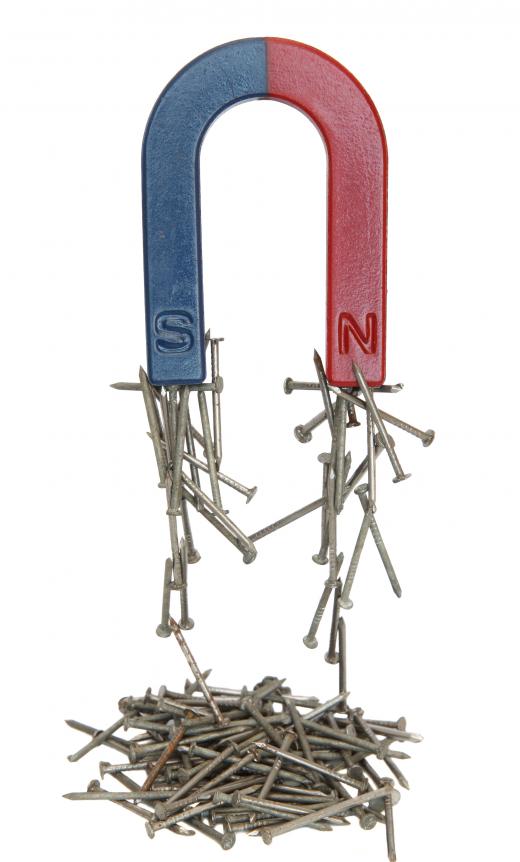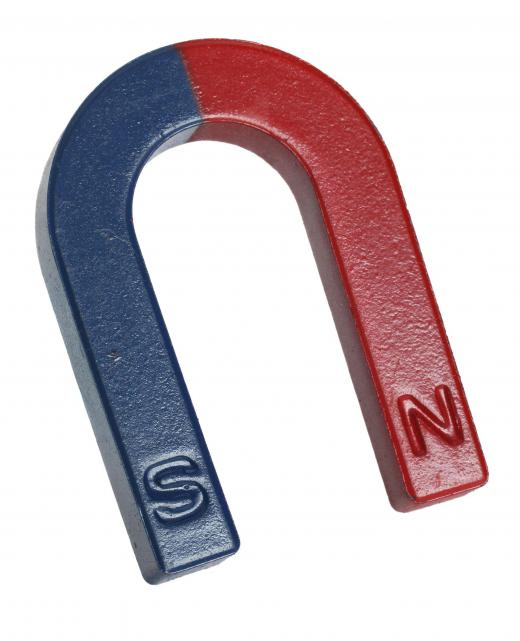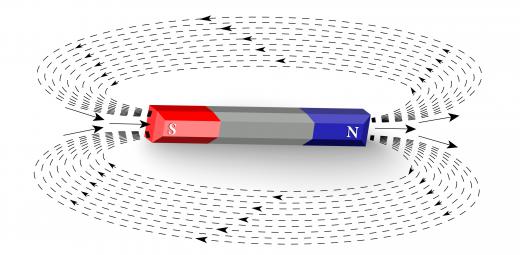What is a Horseshoe Magnet?
A horseshoe magnet is a U-shaped metal object that produces a magnetic field. This magnetic field in invisible, but is responsible for a magnet’s notable pull on other metal objects. It is one type of permanent magnet, meaning that it stays magnetized, as opposed to an electromagnet, whose magnetic field can be started and stopped.
Originally, the horseshoe magnet was made as an alternative to the significantly weaker bar magnet. Its lifting strength is doubled, compared to that of a bar magnet, because both of its magnetic poles point in the same direction. For industrial applications, they have largely been replaced by even stronger magnets, but are still effective for uses such as classroom demonstrations and picking up small metal objects.

Horseshoe and U-shaped magnets come in every size and lifting strength, at prices that are equally varied. Properly kept, they can hold their magnetism for decades. They are common enough that a red U-shaped magnet is the universal symbol of magnets, recognized around the world.
In an electromagnet, the magnetic field is created by electricity moving through a wire. In a horseshoe magnet, the magnetism is produced in the same way — that is, from the movement of electrons. A basic understanding of the structure of atoms is helpful to clarify this idea. Most electrons orbit the nucleus of an atom in pairs, and each electron has a “spin” on it, whether upward or downward, which creates a tiny magnetic field. The spins of paired electrons go in opposite directions, canceling each other out. In other words, there is no net magnetic field.

Atoms of elements that are ferromagnetic, such as iron, have some electrons that are unpaired. This means that their spin is not equalized by another electron, giving the atom a net magnetic field. The magnetism of a whole magnet comes from the alignment of the movement of these unpaired electrons in all of its atoms. The more unpaired electrons there are in an element, the stronger the magnetism of that element can be.

The magnetic properties of matter can be put to use in numerous ways. Horseshoe and many other types of magnets have everyday uses, such as sticking a note to a refrigerator, or picking up metal objects. They are also used in a number of traditional and alternative medical treatments for everything from arthritis to poor circulation. Data storage in credit cards and computers has become perhaps the most common modern use of magnetism.
AS FEATURED ON:
AS FEATURED ON:













Discussion Comments
I heard that a horseshoe magnet is the quickest, simplest and easiest way to detect intergranular corrosion. Could anyone here explain about this, in theory and in detailed explanation?
I didn't realize that a magnet could lose its magnetism. I thought that a magnet was a magnet and always would be!
If a properly kept horseshoe magnet can retain it's magnetism for decades, and this being considered a long time, how long do non-horseshoe magnets hold their magnetism?
How interesting! I didn't know that horseshoe magnets were shaped that way because it made them stronger!
Now that I think about it though, every horseshoe magnet I have ever used was very strong. I have even used one that was actually hard to pull off of the object it was stuck to! It seemed like it was some sort of super magnet!
Post your comments